Analysis of Financial Management Principles: Morrison's Report
VerifiedAdded on 2023/01/11
|19
|5521
|92
Report
AI Summary
This report provides a comprehensive analysis of financial management principles, focusing on their application within the context of Morrison's. It examines both formal and informal approaches to decision-making, emphasizing the importance of knowledge-based approaches in large organizations. Key financial management principles, including developing financial objectives, ethical considerations, and shareholder wealth maximization, are discussed in detail. The report also explores the role and value of management accountants, the use of accounting control systems, and the significance of financial decision-making in ensuring financial sustainability. Furthermore, the report highlights the influence of both internal and external stakeholders on decision-making processes and the importance of ethical compliance and accurate financial reporting. Through the analysis of Morrison's, the report offers practical insights into how these principles contribute to effective financial management and organizational success.
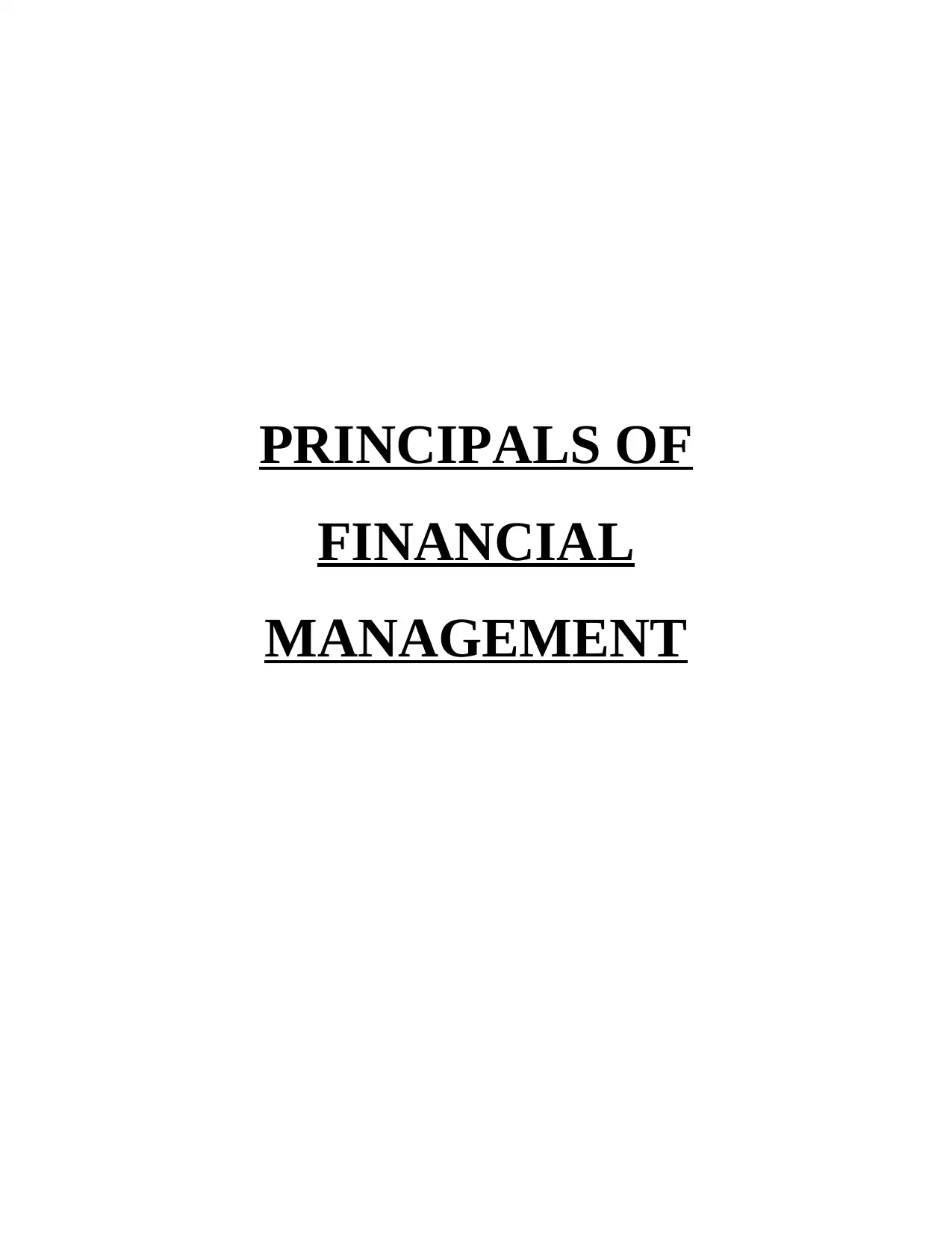
PRINCIPALS OF
FINANCIAL
MANAGEMENT
FINANCIAL
MANAGEMENT
Paraphrase This Document
Need a fresh take? Get an instant paraphrase of this document with our AI Paraphraser
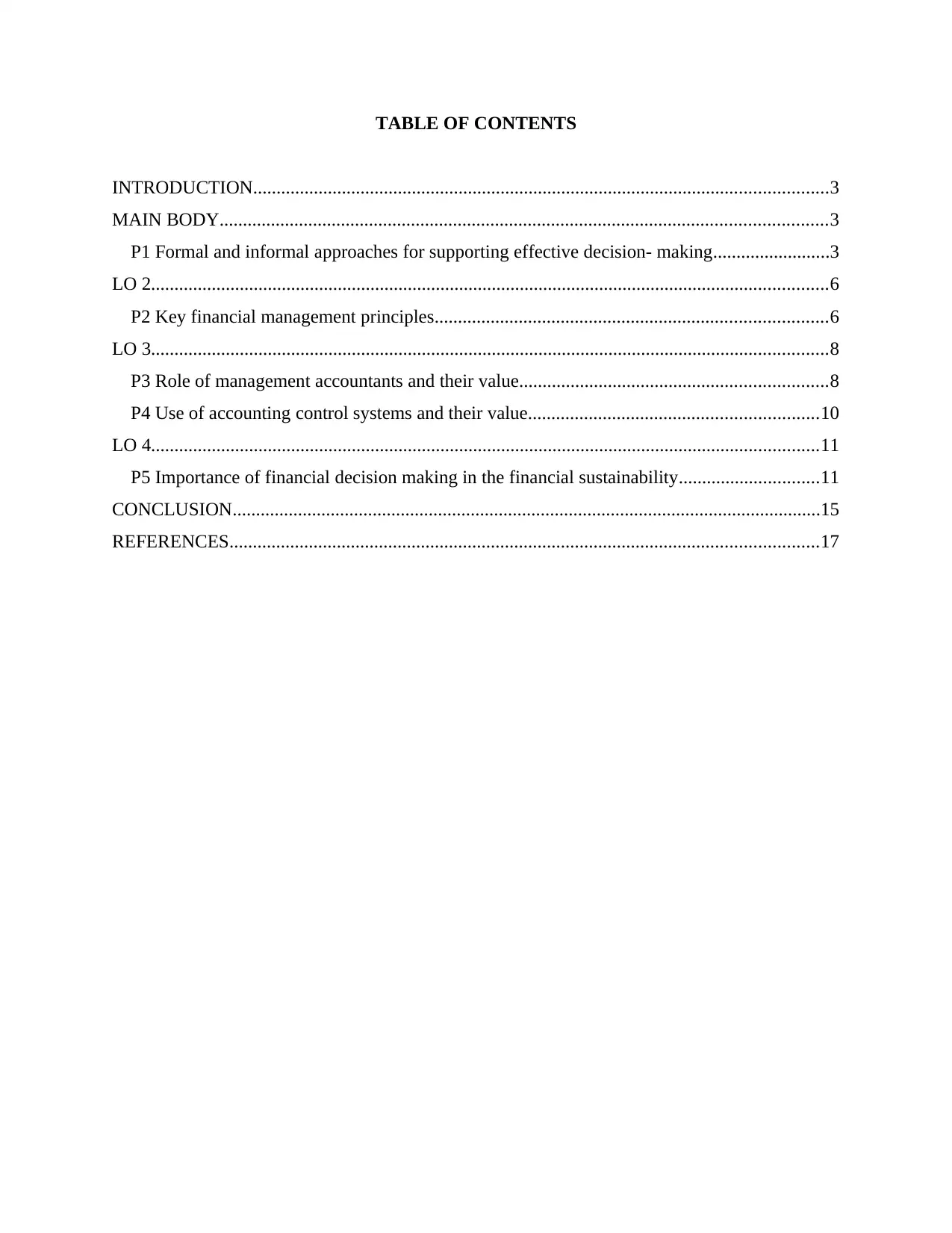
TABLE OF CONTENTS
INTRODUCTION...........................................................................................................................3
MAIN BODY..................................................................................................................................3
P1 Formal and informal approaches for supporting effective decision- making.........................3
LO 2.................................................................................................................................................6
P2 Key financial management principles....................................................................................6
LO 3.................................................................................................................................................8
P3 Role of management accountants and their value..................................................................8
P4 Use of accounting control systems and their value..............................................................10
LO 4...............................................................................................................................................11
P5 Importance of financial decision making in the financial sustainability..............................11
CONCLUSION..............................................................................................................................15
REFERENCES..............................................................................................................................17
INTRODUCTION...........................................................................................................................3
MAIN BODY..................................................................................................................................3
P1 Formal and informal approaches for supporting effective decision- making.........................3
LO 2.................................................................................................................................................6
P2 Key financial management principles....................................................................................6
LO 3.................................................................................................................................................8
P3 Role of management accountants and their value..................................................................8
P4 Use of accounting control systems and their value..............................................................10
LO 4...............................................................................................................................................11
P5 Importance of financial decision making in the financial sustainability..............................11
CONCLUSION..............................................................................................................................15
REFERENCES..............................................................................................................................17
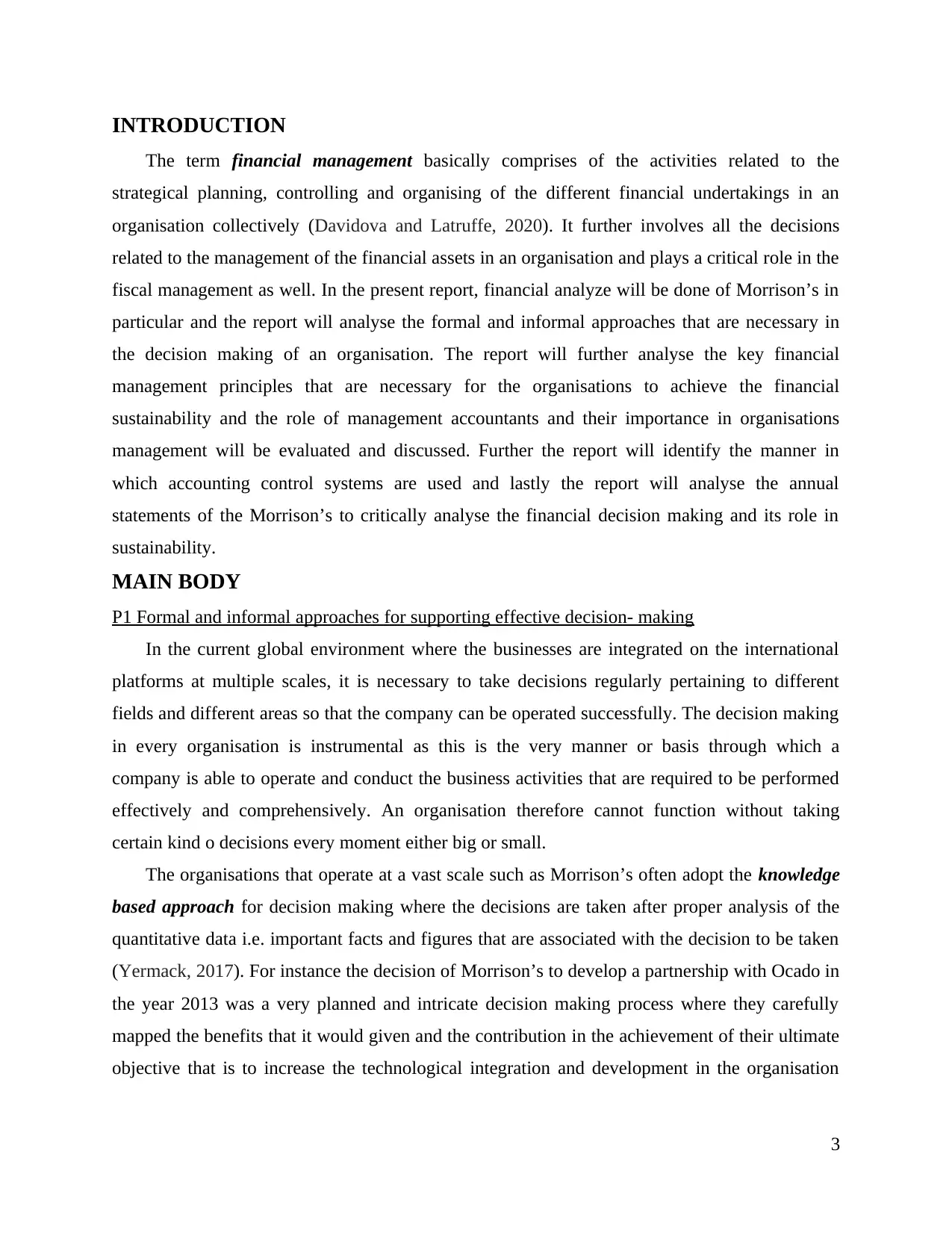
INTRODUCTION
The term financial management basically comprises of the activities related to the
strategical planning, controlling and organising of the different financial undertakings in an
organisation collectively (Davidova and Latruffe, 2020). It further involves all the decisions
related to the management of the financial assets in an organisation and plays a critical role in the
fiscal management as well. In the present report, financial analyze will be done of Morrison’s in
particular and the report will analyse the formal and informal approaches that are necessary in
the decision making of an organisation. The report will further analyse the key financial
management principles that are necessary for the organisations to achieve the financial
sustainability and the role of management accountants and their importance in organisations
management will be evaluated and discussed. Further the report will identify the manner in
which accounting control systems are used and lastly the report will analyse the annual
statements of the Morrison’s to critically analyse the financial decision making and its role in
sustainability.
MAIN BODY
P1 Formal and informal approaches for supporting effective decision- making
In the current global environment where the businesses are integrated on the international
platforms at multiple scales, it is necessary to take decisions regularly pertaining to different
fields and different areas so that the company can be operated successfully. The decision making
in every organisation is instrumental as this is the very manner or basis through which a
company is able to operate and conduct the business activities that are required to be performed
effectively and comprehensively. An organisation therefore cannot function without taking
certain kind o decisions every moment either big or small.
The organisations that operate at a vast scale such as Morrison’s often adopt the knowledge
based approach for decision making where the decisions are taken after proper analysis of the
quantitative data i.e. important facts and figures that are associated with the decision to be taken
(Yermack, 2017). For instance the decision of Morrison’s to develop a partnership with Ocado in
the year 2013 was a very planned and intricate decision making process where they carefully
mapped the benefits that it would given and the contribution in the achievement of their ultimate
objective that is to increase the technological integration and development in the organisation
3
The term financial management basically comprises of the activities related to the
strategical planning, controlling and organising of the different financial undertakings in an
organisation collectively (Davidova and Latruffe, 2020). It further involves all the decisions
related to the management of the financial assets in an organisation and plays a critical role in the
fiscal management as well. In the present report, financial analyze will be done of Morrison’s in
particular and the report will analyse the formal and informal approaches that are necessary in
the decision making of an organisation. The report will further analyse the key financial
management principles that are necessary for the organisations to achieve the financial
sustainability and the role of management accountants and their importance in organisations
management will be evaluated and discussed. Further the report will identify the manner in
which accounting control systems are used and lastly the report will analyse the annual
statements of the Morrison’s to critically analyse the financial decision making and its role in
sustainability.
MAIN BODY
P1 Formal and informal approaches for supporting effective decision- making
In the current global environment where the businesses are integrated on the international
platforms at multiple scales, it is necessary to take decisions regularly pertaining to different
fields and different areas so that the company can be operated successfully. The decision making
in every organisation is instrumental as this is the very manner or basis through which a
company is able to operate and conduct the business activities that are required to be performed
effectively and comprehensively. An organisation therefore cannot function without taking
certain kind o decisions every moment either big or small.
The organisations that operate at a vast scale such as Morrison’s often adopt the knowledge
based approach for decision making where the decisions are taken after proper analysis of the
quantitative data i.e. important facts and figures that are associated with the decision to be taken
(Yermack, 2017). For instance the decision of Morrison’s to develop a partnership with Ocado in
the year 2013 was a very planned and intricate decision making process where they carefully
mapped the benefits that it would given and the contribution in the achievement of their ultimate
objective that is to increase the technological integration and development in the organisation
3
⊘ This is a preview!⊘
Do you want full access?
Subscribe today to unlock all pages.

Trusted by 1+ million students worldwide
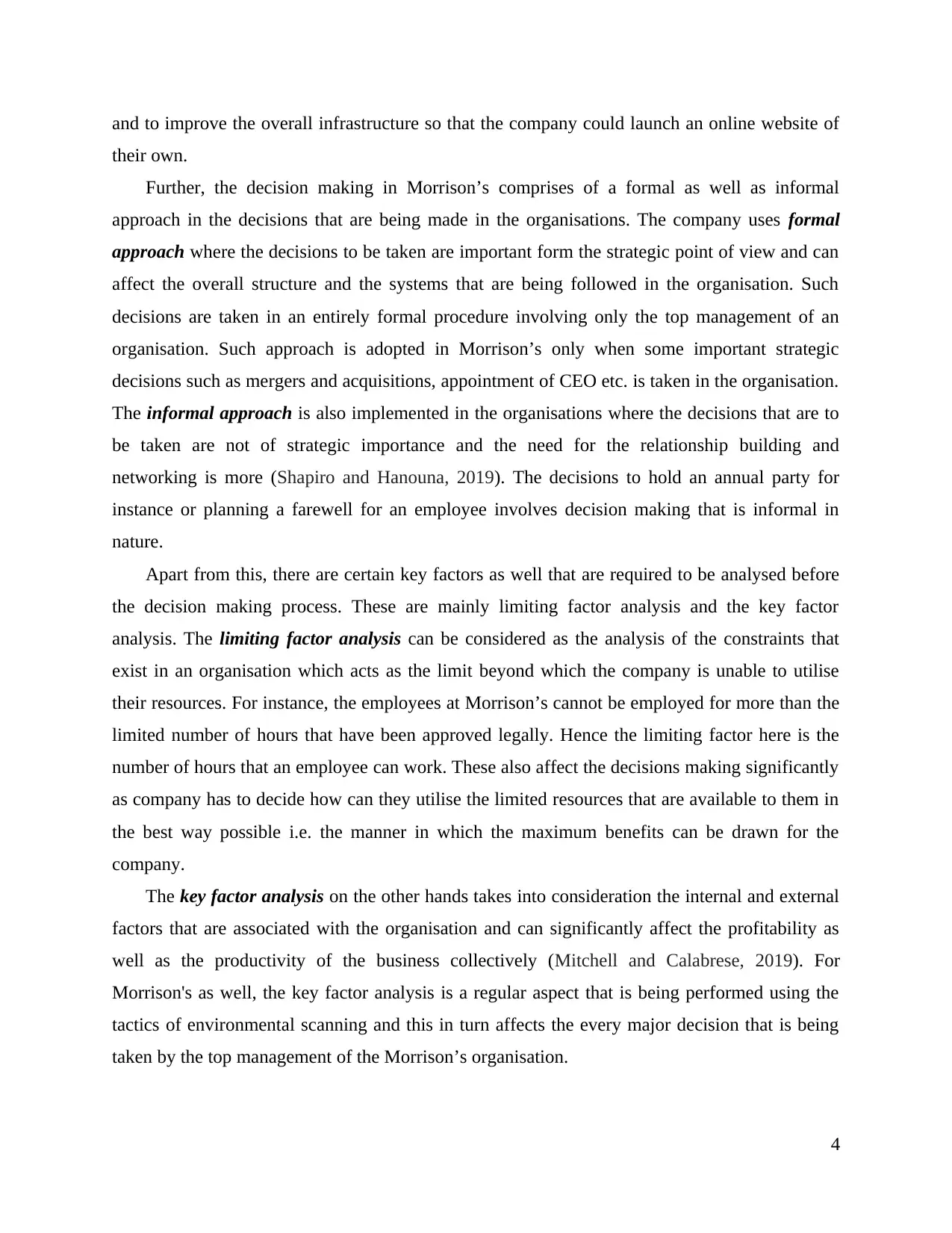
and to improve the overall infrastructure so that the company could launch an online website of
their own.
Further, the decision making in Morrison’s comprises of a formal as well as informal
approach in the decisions that are being made in the organisations. The company uses formal
approach where the decisions to be taken are important form the strategic point of view and can
affect the overall structure and the systems that are being followed in the organisation. Such
decisions are taken in an entirely formal procedure involving only the top management of an
organisation. Such approach is adopted in Morrison’s only when some important strategic
decisions such as mergers and acquisitions, appointment of CEO etc. is taken in the organisation.
The informal approach is also implemented in the organisations where the decisions that are to
be taken are not of strategic importance and the need for the relationship building and
networking is more (Shapiro and Hanouna, 2019). The decisions to hold an annual party for
instance or planning a farewell for an employee involves decision making that is informal in
nature.
Apart from this, there are certain key factors as well that are required to be analysed before
the decision making process. These are mainly limiting factor analysis and the key factor
analysis. The limiting factor analysis can be considered as the analysis of the constraints that
exist in an organisation which acts as the limit beyond which the company is unable to utilise
their resources. For instance, the employees at Morrison’s cannot be employed for more than the
limited number of hours that have been approved legally. Hence the limiting factor here is the
number of hours that an employee can work. These also affect the decisions making significantly
as company has to decide how can they utilise the limited resources that are available to them in
the best way possible i.e. the manner in which the maximum benefits can be drawn for the
company.
The key factor analysis on the other hands takes into consideration the internal and external
factors that are associated with the organisation and can significantly affect the profitability as
well as the productivity of the business collectively (Mitchell and Calabrese, 2019). For
Morrison's as well, the key factor analysis is a regular aspect that is being performed using the
tactics of environmental scanning and this in turn affects the every major decision that is being
taken by the top management of the Morrison’s organisation.
4
their own.
Further, the decision making in Morrison’s comprises of a formal as well as informal
approach in the decisions that are being made in the organisations. The company uses formal
approach where the decisions to be taken are important form the strategic point of view and can
affect the overall structure and the systems that are being followed in the organisation. Such
decisions are taken in an entirely formal procedure involving only the top management of an
organisation. Such approach is adopted in Morrison’s only when some important strategic
decisions such as mergers and acquisitions, appointment of CEO etc. is taken in the organisation.
The informal approach is also implemented in the organisations where the decisions that are to
be taken are not of strategic importance and the need for the relationship building and
networking is more (Shapiro and Hanouna, 2019). The decisions to hold an annual party for
instance or planning a farewell for an employee involves decision making that is informal in
nature.
Apart from this, there are certain key factors as well that are required to be analysed before
the decision making process. These are mainly limiting factor analysis and the key factor
analysis. The limiting factor analysis can be considered as the analysis of the constraints that
exist in an organisation which acts as the limit beyond which the company is unable to utilise
their resources. For instance, the employees at Morrison’s cannot be employed for more than the
limited number of hours that have been approved legally. Hence the limiting factor here is the
number of hours that an employee can work. These also affect the decisions making significantly
as company has to decide how can they utilise the limited resources that are available to them in
the best way possible i.e. the manner in which the maximum benefits can be drawn for the
company.
The key factor analysis on the other hands takes into consideration the internal and external
factors that are associated with the organisation and can significantly affect the profitability as
well as the productivity of the business collectively (Mitchell and Calabrese, 2019). For
Morrison's as well, the key factor analysis is a regular aspect that is being performed using the
tactics of environmental scanning and this in turn affects the every major decision that is being
taken by the top management of the Morrison’s organisation.
4
Paraphrase This Document
Need a fresh take? Get an instant paraphrase of this document with our AI Paraphraser
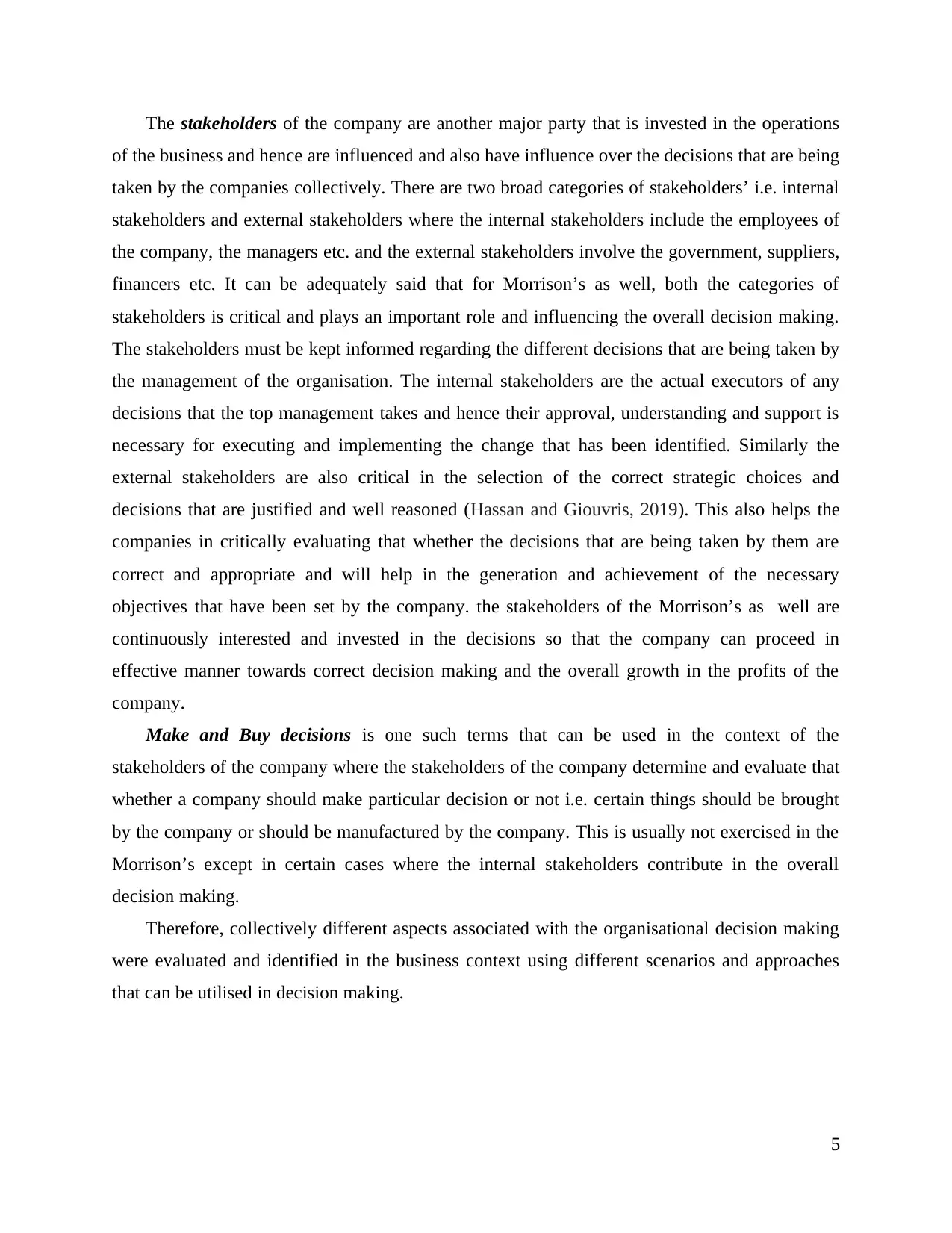
The stakeholders of the company are another major party that is invested in the operations
of the business and hence are influenced and also have influence over the decisions that are being
taken by the companies collectively. There are two broad categories of stakeholders’ i.e. internal
stakeholders and external stakeholders where the internal stakeholders include the employees of
the company, the managers etc. and the external stakeholders involve the government, suppliers,
financers etc. It can be adequately said that for Morrison’s as well, both the categories of
stakeholders is critical and plays an important role and influencing the overall decision making.
The stakeholders must be kept informed regarding the different decisions that are being taken by
the management of the organisation. The internal stakeholders are the actual executors of any
decisions that the top management takes and hence their approval, understanding and support is
necessary for executing and implementing the change that has been identified. Similarly the
external stakeholders are also critical in the selection of the correct strategic choices and
decisions that are justified and well reasoned (Hassan and Giouvris, 2019). This also helps the
companies in critically evaluating that whether the decisions that are being taken by them are
correct and appropriate and will help in the generation and achievement of the necessary
objectives that have been set by the company. the stakeholders of the Morrison’s as well are
continuously interested and invested in the decisions so that the company can proceed in
effective manner towards correct decision making and the overall growth in the profits of the
company.
Make and Buy decisions is one such terms that can be used in the context of the
stakeholders of the company where the stakeholders of the company determine and evaluate that
whether a company should make particular decision or not i.e. certain things should be brought
by the company or should be manufactured by the company. This is usually not exercised in the
Morrison’s except in certain cases where the internal stakeholders contribute in the overall
decision making.
Therefore, collectively different aspects associated with the organisational decision making
were evaluated and identified in the business context using different scenarios and approaches
that can be utilised in decision making.
5
of the business and hence are influenced and also have influence over the decisions that are being
taken by the companies collectively. There are two broad categories of stakeholders’ i.e. internal
stakeholders and external stakeholders where the internal stakeholders include the employees of
the company, the managers etc. and the external stakeholders involve the government, suppliers,
financers etc. It can be adequately said that for Morrison’s as well, both the categories of
stakeholders is critical and plays an important role and influencing the overall decision making.
The stakeholders must be kept informed regarding the different decisions that are being taken by
the management of the organisation. The internal stakeholders are the actual executors of any
decisions that the top management takes and hence their approval, understanding and support is
necessary for executing and implementing the change that has been identified. Similarly the
external stakeholders are also critical in the selection of the correct strategic choices and
decisions that are justified and well reasoned (Hassan and Giouvris, 2019). This also helps the
companies in critically evaluating that whether the decisions that are being taken by them are
correct and appropriate and will help in the generation and achievement of the necessary
objectives that have been set by the company. the stakeholders of the Morrison’s as well are
continuously interested and invested in the decisions so that the company can proceed in
effective manner towards correct decision making and the overall growth in the profits of the
company.
Make and Buy decisions is one such terms that can be used in the context of the
stakeholders of the company where the stakeholders of the company determine and evaluate that
whether a company should make particular decision or not i.e. certain things should be brought
by the company or should be manufactured by the company. This is usually not exercised in the
Morrison’s except in certain cases where the internal stakeholders contribute in the overall
decision making.
Therefore, collectively different aspects associated with the organisational decision making
were evaluated and identified in the business context using different scenarios and approaches
that can be utilised in decision making.
5
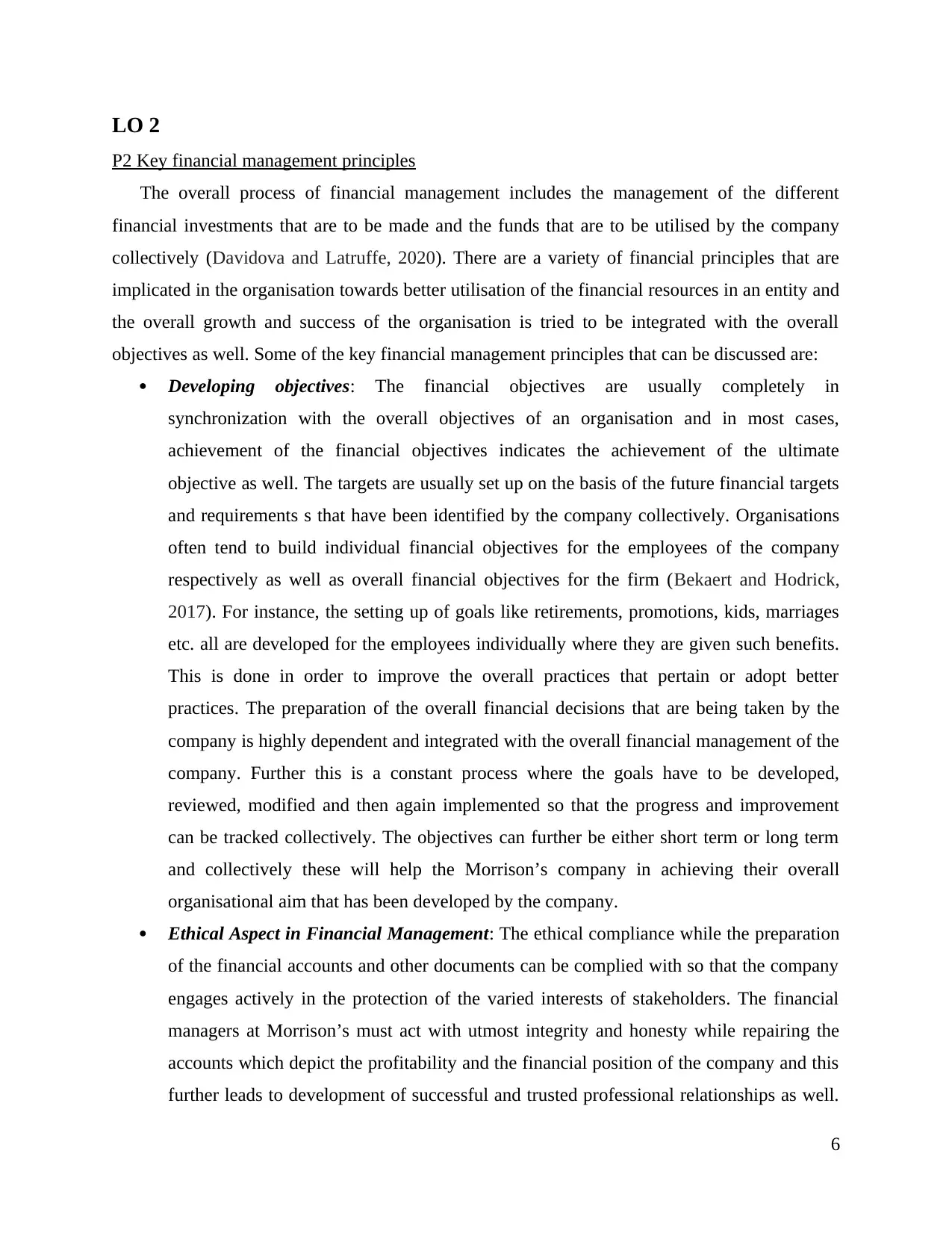
LO 2
P2 Key financial management principles
The overall process of financial management includes the management of the different
financial investments that are to be made and the funds that are to be utilised by the company
collectively (Davidova and Latruffe, 2020). There are a variety of financial principles that are
implicated in the organisation towards better utilisation of the financial resources in an entity and
the overall growth and success of the organisation is tried to be integrated with the overall
objectives as well. Some of the key financial management principles that can be discussed are:
Developing objectives: The financial objectives are usually completely in
synchronization with the overall objectives of an organisation and in most cases,
achievement of the financial objectives indicates the achievement of the ultimate
objective as well. The targets are usually set up on the basis of the future financial targets
and requirements s that have been identified by the company collectively. Organisations
often tend to build individual financial objectives for the employees of the company
respectively as well as overall financial objectives for the firm (Bekaert and Hodrick,
2017). For instance, the setting up of goals like retirements, promotions, kids, marriages
etc. all are developed for the employees individually where they are given such benefits.
This is done in order to improve the overall practices that pertain or adopt better
practices. The preparation of the overall financial decisions that are being taken by the
company is highly dependent and integrated with the overall financial management of the
company. Further this is a constant process where the goals have to be developed,
reviewed, modified and then again implemented so that the progress and improvement
can be tracked collectively. The objectives can further be either short term or long term
and collectively these will help the Morrison’s company in achieving their overall
organisational aim that has been developed by the company.
Ethical Aspect in Financial Management: The ethical compliance while the preparation
of the financial accounts and other documents can be complied with so that the company
engages actively in the protection of the varied interests of stakeholders. The financial
managers at Morrison’s must act with utmost integrity and honesty while repairing the
accounts which depict the profitability and the financial position of the company and this
further leads to development of successful and trusted professional relationships as well.
6
P2 Key financial management principles
The overall process of financial management includes the management of the different
financial investments that are to be made and the funds that are to be utilised by the company
collectively (Davidova and Latruffe, 2020). There are a variety of financial principles that are
implicated in the organisation towards better utilisation of the financial resources in an entity and
the overall growth and success of the organisation is tried to be integrated with the overall
objectives as well. Some of the key financial management principles that can be discussed are:
Developing objectives: The financial objectives are usually completely in
synchronization with the overall objectives of an organisation and in most cases,
achievement of the financial objectives indicates the achievement of the ultimate
objective as well. The targets are usually set up on the basis of the future financial targets
and requirements s that have been identified by the company collectively. Organisations
often tend to build individual financial objectives for the employees of the company
respectively as well as overall financial objectives for the firm (Bekaert and Hodrick,
2017). For instance, the setting up of goals like retirements, promotions, kids, marriages
etc. all are developed for the employees individually where they are given such benefits.
This is done in order to improve the overall practices that pertain or adopt better
practices. The preparation of the overall financial decisions that are being taken by the
company is highly dependent and integrated with the overall financial management of the
company. Further this is a constant process where the goals have to be developed,
reviewed, modified and then again implemented so that the progress and improvement
can be tracked collectively. The objectives can further be either short term or long term
and collectively these will help the Morrison’s company in achieving their overall
organisational aim that has been developed by the company.
Ethical Aspect in Financial Management: The ethical compliance while the preparation
of the financial accounts and other documents can be complied with so that the company
engages actively in the protection of the varied interests of stakeholders. The financial
managers at Morrison’s must act with utmost integrity and honesty while repairing the
accounts which depict the profitability and the financial position of the company and this
further leads to development of successful and trusted professional relationships as well.
6
⊘ This is a preview!⊘
Do you want full access?
Subscribe today to unlock all pages.

Trusted by 1+ million students worldwide
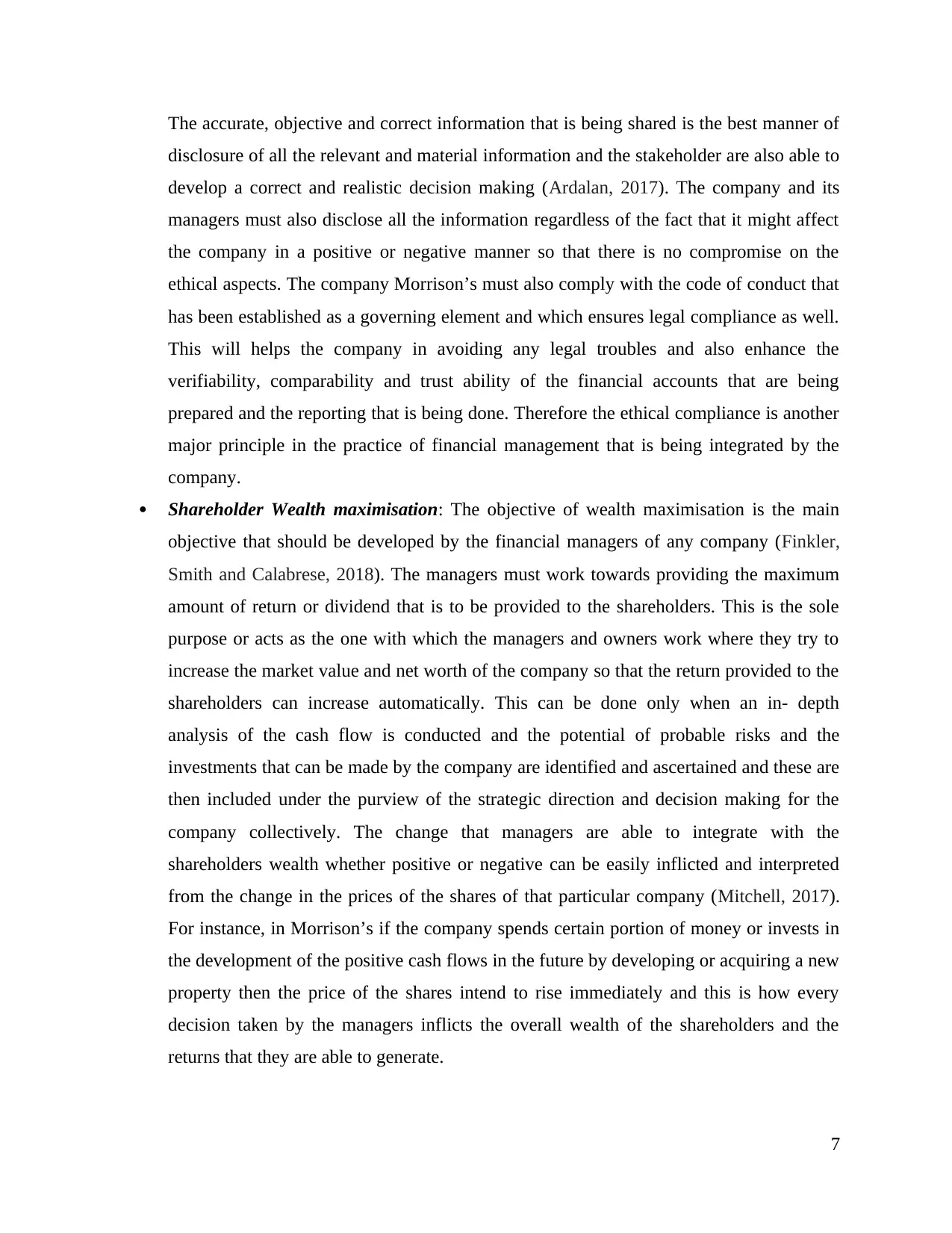
The accurate, objective and correct information that is being shared is the best manner of
disclosure of all the relevant and material information and the stakeholder are also able to
develop a correct and realistic decision making (Ardalan, 2017). The company and its
managers must also disclose all the information regardless of the fact that it might affect
the company in a positive or negative manner so that there is no compromise on the
ethical aspects. The company Morrison’s must also comply with the code of conduct that
has been established as a governing element and which ensures legal compliance as well.
This will helps the company in avoiding any legal troubles and also enhance the
verifiability, comparability and trust ability of the financial accounts that are being
prepared and the reporting that is being done. Therefore the ethical compliance is another
major principle in the practice of financial management that is being integrated by the
company.
Shareholder Wealth maximisation: The objective of wealth maximisation is the main
objective that should be developed by the financial managers of any company (Finkler,
Smith and Calabrese, 2018). The managers must work towards providing the maximum
amount of return or dividend that is to be provided to the shareholders. This is the sole
purpose or acts as the one with which the managers and owners work where they try to
increase the market value and net worth of the company so that the return provided to the
shareholders can increase automatically. This can be done only when an in- depth
analysis of the cash flow is conducted and the potential of probable risks and the
investments that can be made by the company are identified and ascertained and these are
then included under the purview of the strategic direction and decision making for the
company collectively. The change that managers are able to integrate with the
shareholders wealth whether positive or negative can be easily inflicted and interpreted
from the change in the prices of the shares of that particular company (Mitchell, 2017).
For instance, in Morrison’s if the company spends certain portion of money or invests in
the development of the positive cash flows in the future by developing or acquiring a new
property then the price of the shares intend to rise immediately and this is how every
decision taken by the managers inflicts the overall wealth of the shareholders and the
returns that they are able to generate.
7
disclosure of all the relevant and material information and the stakeholder are also able to
develop a correct and realistic decision making (Ardalan, 2017). The company and its
managers must also disclose all the information regardless of the fact that it might affect
the company in a positive or negative manner so that there is no compromise on the
ethical aspects. The company Morrison’s must also comply with the code of conduct that
has been established as a governing element and which ensures legal compliance as well.
This will helps the company in avoiding any legal troubles and also enhance the
verifiability, comparability and trust ability of the financial accounts that are being
prepared and the reporting that is being done. Therefore the ethical compliance is another
major principle in the practice of financial management that is being integrated by the
company.
Shareholder Wealth maximisation: The objective of wealth maximisation is the main
objective that should be developed by the financial managers of any company (Finkler,
Smith and Calabrese, 2018). The managers must work towards providing the maximum
amount of return or dividend that is to be provided to the shareholders. This is the sole
purpose or acts as the one with which the managers and owners work where they try to
increase the market value and net worth of the company so that the return provided to the
shareholders can increase automatically. This can be done only when an in- depth
analysis of the cash flow is conducted and the potential of probable risks and the
investments that can be made by the company are identified and ascertained and these are
then included under the purview of the strategic direction and decision making for the
company collectively. The change that managers are able to integrate with the
shareholders wealth whether positive or negative can be easily inflicted and interpreted
from the change in the prices of the shares of that particular company (Mitchell, 2017).
For instance, in Morrison’s if the company spends certain portion of money or invests in
the development of the positive cash flows in the future by developing or acquiring a new
property then the price of the shares intend to rise immediately and this is how every
decision taken by the managers inflicts the overall wealth of the shareholders and the
returns that they are able to generate.
7
Paraphrase This Document
Need a fresh take? Get an instant paraphrase of this document with our AI Paraphraser
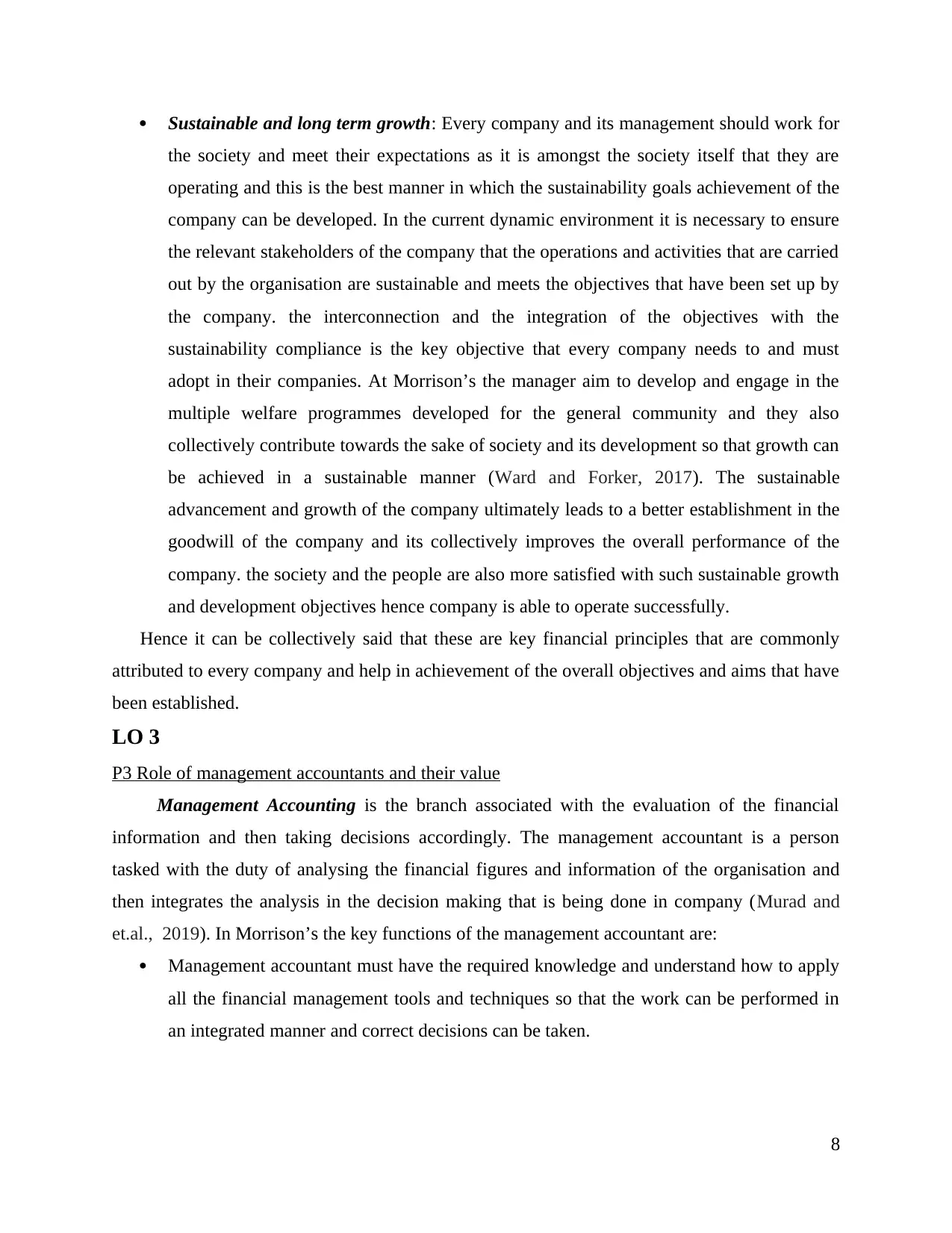
Sustainable and long term growth: Every company and its management should work for
the society and meet their expectations as it is amongst the society itself that they are
operating and this is the best manner in which the sustainability goals achievement of the
company can be developed. In the current dynamic environment it is necessary to ensure
the relevant stakeholders of the company that the operations and activities that are carried
out by the organisation are sustainable and meets the objectives that have been set up by
the company. the interconnection and the integration of the objectives with the
sustainability compliance is the key objective that every company needs to and must
adopt in their companies. At Morrison’s the manager aim to develop and engage in the
multiple welfare programmes developed for the general community and they also
collectively contribute towards the sake of society and its development so that growth can
be achieved in a sustainable manner (Ward and Forker, 2017). The sustainable
advancement and growth of the company ultimately leads to a better establishment in the
goodwill of the company and its collectively improves the overall performance of the
company. the society and the people are also more satisfied with such sustainable growth
and development objectives hence company is able to operate successfully.
Hence it can be collectively said that these are key financial principles that are commonly
attributed to every company and help in achievement of the overall objectives and aims that have
been established.
LO 3
P3 Role of management accountants and their value
Management Accounting is the branch associated with the evaluation of the financial
information and then taking decisions accordingly. The management accountant is a person
tasked with the duty of analysing the financial figures and information of the organisation and
then integrates the analysis in the decision making that is being done in company (Murad and
et.al., 2019). In Morrison’s the key functions of the management accountant are:
Management accountant must have the required knowledge and understand how to apply
all the financial management tools and techniques so that the work can be performed in
an integrated manner and correct decisions can be taken.
8
the society and meet their expectations as it is amongst the society itself that they are
operating and this is the best manner in which the sustainability goals achievement of the
company can be developed. In the current dynamic environment it is necessary to ensure
the relevant stakeholders of the company that the operations and activities that are carried
out by the organisation are sustainable and meets the objectives that have been set up by
the company. the interconnection and the integration of the objectives with the
sustainability compliance is the key objective that every company needs to and must
adopt in their companies. At Morrison’s the manager aim to develop and engage in the
multiple welfare programmes developed for the general community and they also
collectively contribute towards the sake of society and its development so that growth can
be achieved in a sustainable manner (Ward and Forker, 2017). The sustainable
advancement and growth of the company ultimately leads to a better establishment in the
goodwill of the company and its collectively improves the overall performance of the
company. the society and the people are also more satisfied with such sustainable growth
and development objectives hence company is able to operate successfully.
Hence it can be collectively said that these are key financial principles that are commonly
attributed to every company and help in achievement of the overall objectives and aims that have
been established.
LO 3
P3 Role of management accountants and their value
Management Accounting is the branch associated with the evaluation of the financial
information and then taking decisions accordingly. The management accountant is a person
tasked with the duty of analysing the financial figures and information of the organisation and
then integrates the analysis in the decision making that is being done in company (Murad and
et.al., 2019). In Morrison’s the key functions of the management accountant are:
Management accountant must have the required knowledge and understand how to apply
all the financial management tools and techniques so that the work can be performed in
an integrated manner and correct decisions can be taken.
8
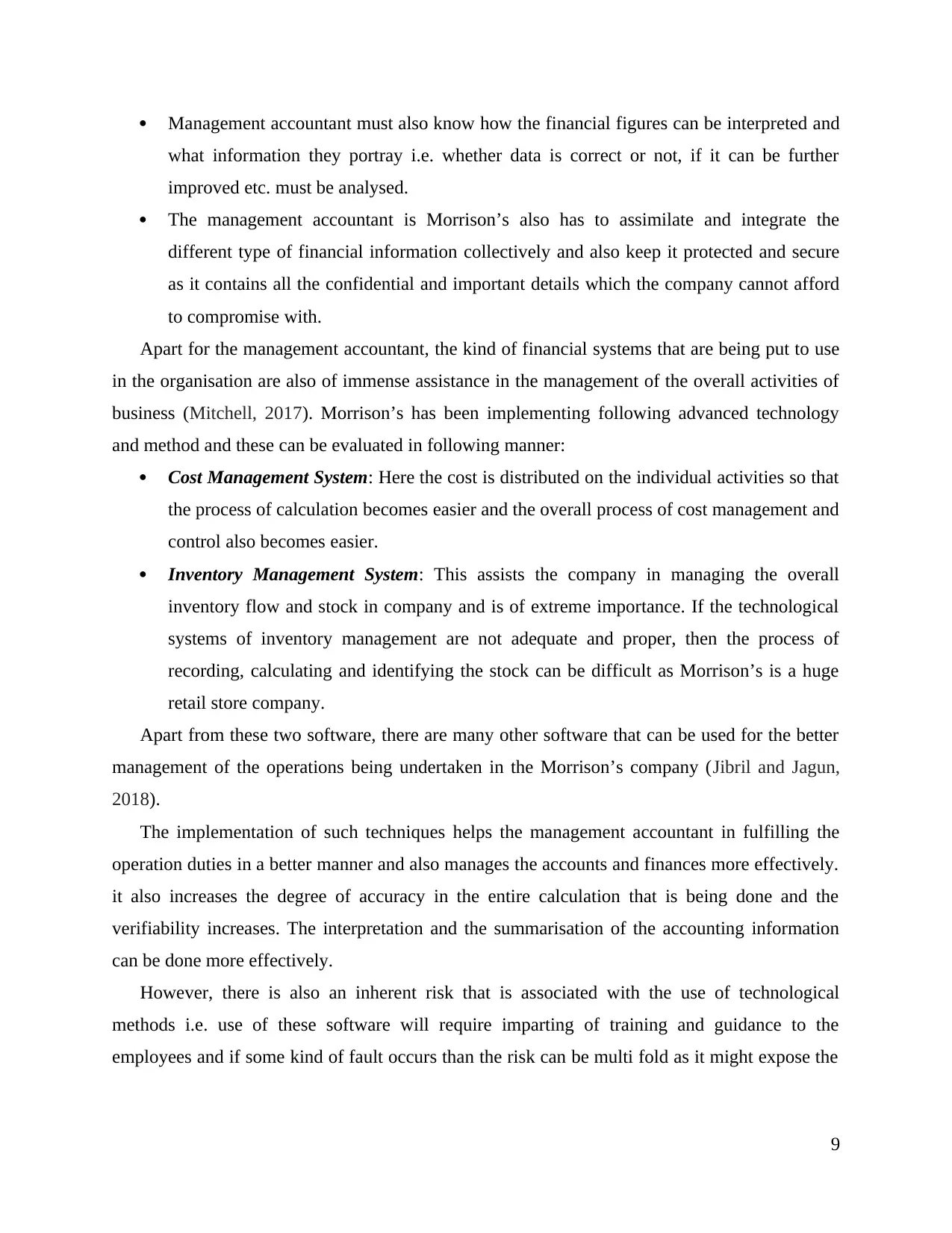
Management accountant must also know how the financial figures can be interpreted and
what information they portray i.e. whether data is correct or not, if it can be further
improved etc. must be analysed.
The management accountant is Morrison’s also has to assimilate and integrate the
different type of financial information collectively and also keep it protected and secure
as it contains all the confidential and important details which the company cannot afford
to compromise with.
Apart for the management accountant, the kind of financial systems that are being put to use
in the organisation are also of immense assistance in the management of the overall activities of
business (Mitchell, 2017). Morrison’s has been implementing following advanced technology
and method and these can be evaluated in following manner:
Cost Management System: Here the cost is distributed on the individual activities so that
the process of calculation becomes easier and the overall process of cost management and
control also becomes easier.
Inventory Management System: This assists the company in managing the overall
inventory flow and stock in company and is of extreme importance. If the technological
systems of inventory management are not adequate and proper, then the process of
recording, calculating and identifying the stock can be difficult as Morrison’s is a huge
retail store company.
Apart from these two software, there are many other software that can be used for the better
management of the operations being undertaken in the Morrison’s company (Jibril and Jagun,
2018).
The implementation of such techniques helps the management accountant in fulfilling the
operation duties in a better manner and also manages the accounts and finances more effectively.
it also increases the degree of accuracy in the entire calculation that is being done and the
verifiability increases. The interpretation and the summarisation of the accounting information
can be done more effectively.
However, there is also an inherent risk that is associated with the use of technological
methods i.e. use of these software will require imparting of training and guidance to the
employees and if some kind of fault occurs than the risk can be multi fold as it might expose the
9
what information they portray i.e. whether data is correct or not, if it can be further
improved etc. must be analysed.
The management accountant is Morrison’s also has to assimilate and integrate the
different type of financial information collectively and also keep it protected and secure
as it contains all the confidential and important details which the company cannot afford
to compromise with.
Apart for the management accountant, the kind of financial systems that are being put to use
in the organisation are also of immense assistance in the management of the overall activities of
business (Mitchell, 2017). Morrison’s has been implementing following advanced technology
and method and these can be evaluated in following manner:
Cost Management System: Here the cost is distributed on the individual activities so that
the process of calculation becomes easier and the overall process of cost management and
control also becomes easier.
Inventory Management System: This assists the company in managing the overall
inventory flow and stock in company and is of extreme importance. If the technological
systems of inventory management are not adequate and proper, then the process of
recording, calculating and identifying the stock can be difficult as Morrison’s is a huge
retail store company.
Apart from these two software, there are many other software that can be used for the better
management of the operations being undertaken in the Morrison’s company (Jibril and Jagun,
2018).
The implementation of such techniques helps the management accountant in fulfilling the
operation duties in a better manner and also manages the accounts and finances more effectively.
it also increases the degree of accuracy in the entire calculation that is being done and the
verifiability increases. The interpretation and the summarisation of the accounting information
can be done more effectively.
However, there is also an inherent risk that is associated with the use of technological
methods i.e. use of these software will require imparting of training and guidance to the
employees and if some kind of fault occurs than the risk can be multi fold as it might expose the
9
⊘ This is a preview!⊘
Do you want full access?
Subscribe today to unlock all pages.

Trusted by 1+ million students worldwide
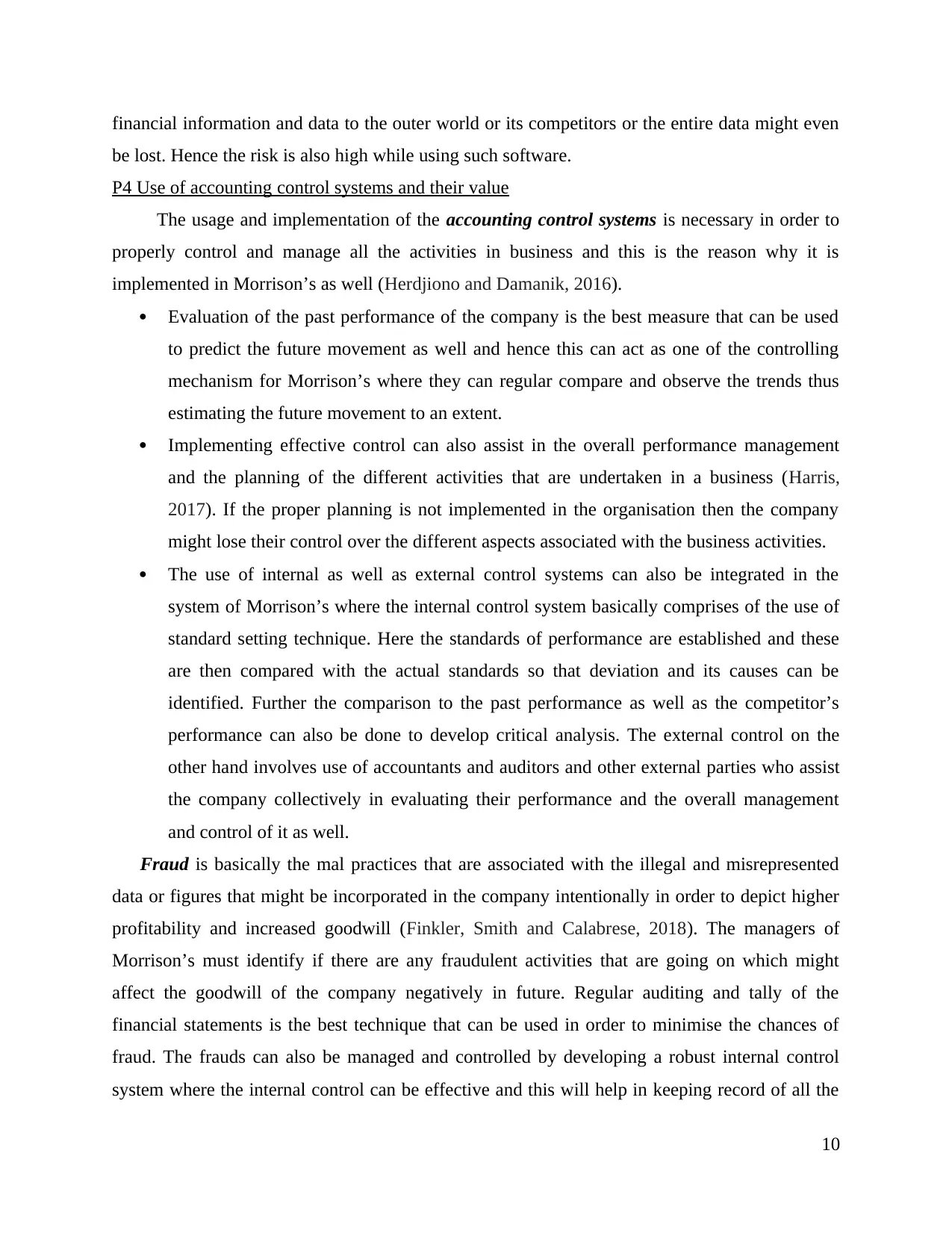
financial information and data to the outer world or its competitors or the entire data might even
be lost. Hence the risk is also high while using such software.
P4 Use of accounting control systems and their value
The usage and implementation of the accounting control systems is necessary in order to
properly control and manage all the activities in business and this is the reason why it is
implemented in Morrison’s as well (Herdjiono and Damanik, 2016).
Evaluation of the past performance of the company is the best measure that can be used
to predict the future movement as well and hence this can act as one of the controlling
mechanism for Morrison’s where they can regular compare and observe the trends thus
estimating the future movement to an extent.
Implementing effective control can also assist in the overall performance management
and the planning of the different activities that are undertaken in a business (Harris,
2017). If the proper planning is not implemented in the organisation then the company
might lose their control over the different aspects associated with the business activities.
The use of internal as well as external control systems can also be integrated in the
system of Morrison’s where the internal control system basically comprises of the use of
standard setting technique. Here the standards of performance are established and these
are then compared with the actual standards so that deviation and its causes can be
identified. Further the comparison to the past performance as well as the competitor’s
performance can also be done to develop critical analysis. The external control on the
other hand involves use of accountants and auditors and other external parties who assist
the company collectively in evaluating their performance and the overall management
and control of it as well.
Fraud is basically the mal practices that are associated with the illegal and misrepresented
data or figures that might be incorporated in the company intentionally in order to depict higher
profitability and increased goodwill (Finkler, Smith and Calabrese, 2018). The managers of
Morrison’s must identify if there are any fraudulent activities that are going on which might
affect the goodwill of the company negatively in future. Regular auditing and tally of the
financial statements is the best technique that can be used in order to minimise the chances of
fraud. The frauds can also be managed and controlled by developing a robust internal control
system where the internal control can be effective and this will help in keeping record of all the
10
be lost. Hence the risk is also high while using such software.
P4 Use of accounting control systems and their value
The usage and implementation of the accounting control systems is necessary in order to
properly control and manage all the activities in business and this is the reason why it is
implemented in Morrison’s as well (Herdjiono and Damanik, 2016).
Evaluation of the past performance of the company is the best measure that can be used
to predict the future movement as well and hence this can act as one of the controlling
mechanism for Morrison’s where they can regular compare and observe the trends thus
estimating the future movement to an extent.
Implementing effective control can also assist in the overall performance management
and the planning of the different activities that are undertaken in a business (Harris,
2017). If the proper planning is not implemented in the organisation then the company
might lose their control over the different aspects associated with the business activities.
The use of internal as well as external control systems can also be integrated in the
system of Morrison’s where the internal control system basically comprises of the use of
standard setting technique. Here the standards of performance are established and these
are then compared with the actual standards so that deviation and its causes can be
identified. Further the comparison to the past performance as well as the competitor’s
performance can also be done to develop critical analysis. The external control on the
other hand involves use of accountants and auditors and other external parties who assist
the company collectively in evaluating their performance and the overall management
and control of it as well.
Fraud is basically the mal practices that are associated with the illegal and misrepresented
data or figures that might be incorporated in the company intentionally in order to depict higher
profitability and increased goodwill (Finkler, Smith and Calabrese, 2018). The managers of
Morrison’s must identify if there are any fraudulent activities that are going on which might
affect the goodwill of the company negatively in future. Regular auditing and tally of the
financial statements is the best technique that can be used in order to minimise the chances of
fraud. The frauds can also be managed and controlled by developing a robust internal control
system where the internal control can be effective and this will help in keeping record of all the
10
Paraphrase This Document
Need a fresh take? Get an instant paraphrase of this document with our AI Paraphraser
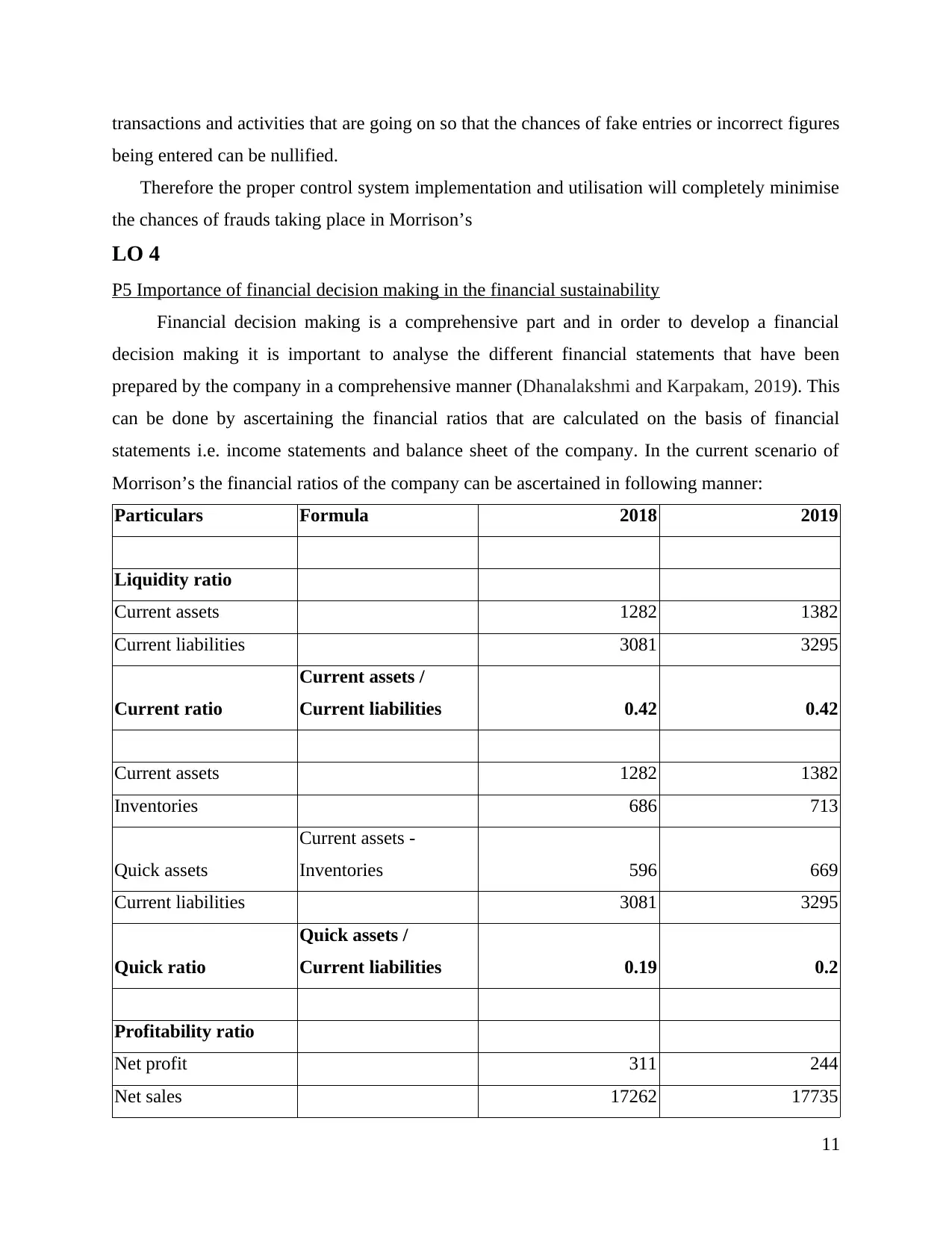
transactions and activities that are going on so that the chances of fake entries or incorrect figures
being entered can be nullified.
Therefore the proper control system implementation and utilisation will completely minimise
the chances of frauds taking place in Morrison’s
LO 4
P5 Importance of financial decision making in the financial sustainability
Financial decision making is a comprehensive part and in order to develop a financial
decision making it is important to analyse the different financial statements that have been
prepared by the company in a comprehensive manner (Dhanalakshmi and Karpakam, 2019). This
can be done by ascertaining the financial ratios that are calculated on the basis of financial
statements i.e. income statements and balance sheet of the company. In the current scenario of
Morrison’s the financial ratios of the company can be ascertained in following manner:
Particulars Formula 2018 2019
Liquidity ratio
Current assets 1282 1382
Current liabilities 3081 3295
Current ratio
Current assets /
Current liabilities 0.42 0.42
Current assets 1282 1382
Inventories 686 713
Quick assets
Current assets -
Inventories 596 669
Current liabilities 3081 3295
Quick ratio
Quick assets /
Current liabilities 0.19 0.2
Profitability ratio
Net profit 311 244
Net sales 17262 17735
11
being entered can be nullified.
Therefore the proper control system implementation and utilisation will completely minimise
the chances of frauds taking place in Morrison’s
LO 4
P5 Importance of financial decision making in the financial sustainability
Financial decision making is a comprehensive part and in order to develop a financial
decision making it is important to analyse the different financial statements that have been
prepared by the company in a comprehensive manner (Dhanalakshmi and Karpakam, 2019). This
can be done by ascertaining the financial ratios that are calculated on the basis of financial
statements i.e. income statements and balance sheet of the company. In the current scenario of
Morrison’s the financial ratios of the company can be ascertained in following manner:
Particulars Formula 2018 2019
Liquidity ratio
Current assets 1282 1382
Current liabilities 3081 3295
Current ratio
Current assets /
Current liabilities 0.42 0.42
Current assets 1282 1382
Inventories 686 713
Quick assets
Current assets -
Inventories 596 669
Current liabilities 3081 3295
Quick ratio
Quick assets /
Current liabilities 0.19 0.2
Profitability ratio
Net profit 311 244
Net sales 17262 17735
11
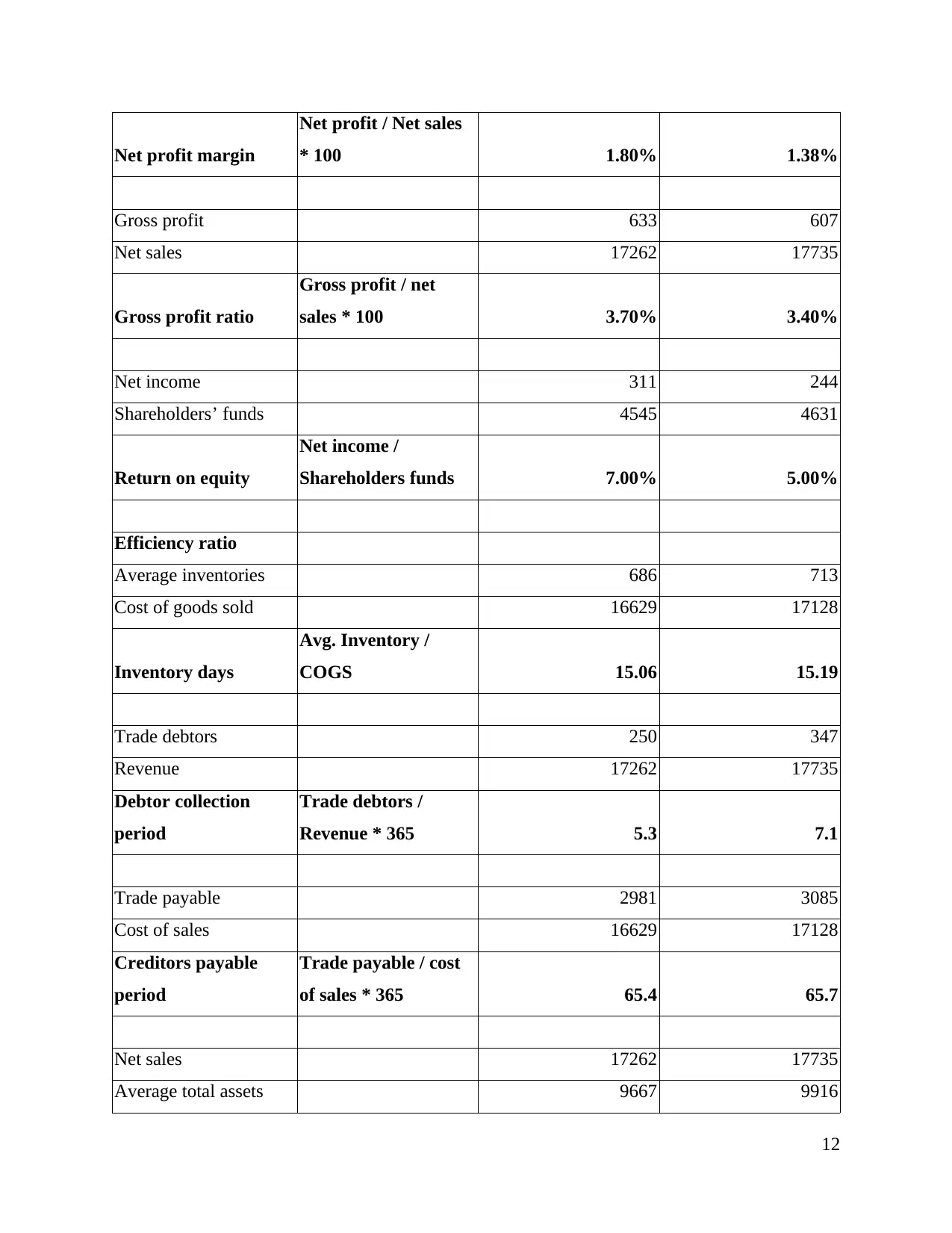
Net profit margin
Net profit / Net sales
* 100 1.80% 1.38%
Gross profit 633 607
Net sales 17262 17735
Gross profit ratio
Gross profit / net
sales * 100 3.70% 3.40%
Net income 311 244
Shareholders’ funds 4545 4631
Return on equity
Net income /
Shareholders funds 7.00% 5.00%
Efficiency ratio
Average inventories 686 713
Cost of goods sold 16629 17128
Inventory days
Avg. Inventory /
COGS 15.06 15.19
Trade debtors 250 347
Revenue 17262 17735
Debtor collection
period
Trade debtors /
Revenue * 365 5.3 7.1
Trade payable 2981 3085
Cost of sales 16629 17128
Creditors payable
period
Trade payable / cost
of sales * 365 65.4 65.7
Net sales 17262 17735
Average total assets 9667 9916
12
Net profit / Net sales
* 100 1.80% 1.38%
Gross profit 633 607
Net sales 17262 17735
Gross profit ratio
Gross profit / net
sales * 100 3.70% 3.40%
Net income 311 244
Shareholders’ funds 4545 4631
Return on equity
Net income /
Shareholders funds 7.00% 5.00%
Efficiency ratio
Average inventories 686 713
Cost of goods sold 16629 17128
Inventory days
Avg. Inventory /
COGS 15.06 15.19
Trade debtors 250 347
Revenue 17262 17735
Debtor collection
period
Trade debtors /
Revenue * 365 5.3 7.1
Trade payable 2981 3085
Cost of sales 16629 17128
Creditors payable
period
Trade payable / cost
of sales * 365 65.4 65.7
Net sales 17262 17735
Average total assets 9667 9916
12
⊘ This is a preview!⊘
Do you want full access?
Subscribe today to unlock all pages.

Trusted by 1+ million students worldwide
1 out of 19
Related Documents
Your All-in-One AI-Powered Toolkit for Academic Success.
+13062052269
info@desklib.com
Available 24*7 on WhatsApp / Email
![[object Object]](/_next/static/media/star-bottom.7253800d.svg)
Unlock your academic potential
Copyright © 2020–2025 A2Z Services. All Rights Reserved. Developed and managed by ZUCOL.





